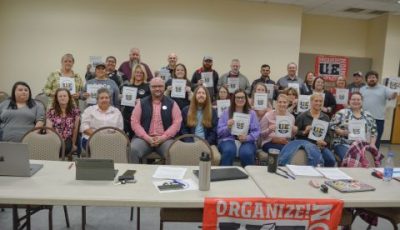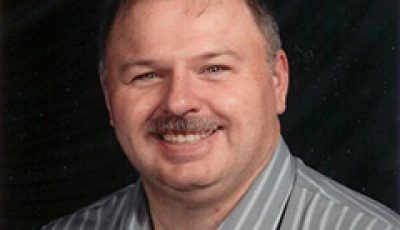Ky. Consular Center celebrates 17th anniversary
When the Kentucky Consular Center first opened in Williamsburg on Oct. 25, 2000, it employed 45 people to administer the U.S. Diversity Visa program.

Kentucky Consular Center Director Chris Beard addressed workers during a 17th Anniversary celebration held at the facility on Oct. 25.
At the time, roughly half of the building, which is located off US25W near Exit 15, was filed with boxes of visa applications that were stacked to the building’s high ceilings.
Last Wednesday, the Kentucky Consular Center celebrated its 17th anniversary with a workforce nearly 10 times as large as the one it started with in 2000.
The boxes stacked to the ceiling have largely been replaced with digital files as the facility still works to administer the U.S. Diversity Visa program, but has added other work to support the U.S. border security programs and operations at U.S. embassies around the world.
Instead of boxes, the facility is now filed with office cubicles and workers doing a number of jobs electronically.
“This place has lasted 17 years, and it has grown from 45 people to over 400 and probably on its way to 450 people because of the quality and hard work of the folks we have,” Kentucky Consular Center Director Chris Beard told his staff gathered for the anniversary celebration last Wednesday.
“I know our reputation with the state department is that we have some of the finest workers and staff … We get things done and we get them done well.”
“Happy 17th birthday KCC,” added Deputy Director Virginia Combs. “I have been here for most of those 17 years and I really appreciate the growth and the work that you all do.”
Adam Bryant, assistant operations manager, said that 50,000 out of the 55,000 Diversity Visas applications randomly selected each year from eligible countries are processed through the Williamsburg facility.
Since the program has gone digital, the center only has about 20 employees working on Diversity Visa applications.
 Facial recognition work
Facial recognition work
One other major area that the Kentucky Consular Center works in now is facial recognition, which is a program that was pioneered at the Williamsburg facility several years ago.
The Diversity Visa program has a rule that you can’t apply more than once a year, and the facial recognition program started out around 2006.
Bryant said that over time, workers started to notice that they could see that the same photos or the same names were showing up so they developed a process for comparing the photos from the different applications.
“From that origin, things started going electronic, but that was the genesis where the whole facial recognition program got started. It was from here from this small little unit,” Bryant noted.
Workers in Williamsburg now do facial recognition work for about 250 diplomatic posts that are located overseas in addition to work checking for matches on U.S. passports from several states.
Operations Manager James Jackson said that around 40 million facial recognition tests are conducted in Williamsburg each year.
Kurt Marlow does about 2,000 facial recognition tests each day.
Workers will open a file showing an applicant and other possible matches a computer has identified from pictures in the database.
Marlow said that everyone has their own process, but he starts by checking the ears, which don’t change much over time, and then goes onto other physical traits that aren’t easily changeable.
If Marlow isn’t sure, he can call over other co-workers in the facial recognition department, and they will look at certain features in order to make a determination.
Once Williamsburg workers determine whether the images are possible matches, they can’t go back and look at the image again.
It is then forwarded to another agency, which has demographic information that the Kentucky Consular Center doesn’t have access to for another review, Combs said.
Marlow noted that the government will periodically bring in representatives from other agencies, departments and so forth to examine how the facial recognition work is done in Williamsburg.
“The folks, who do the facial recognition work here, are recognized as some of the best in the business. They really pioneered the work here over the years,” Marlow said.
“This is one key thing keeping U.S. passports for U.S. citizens and visas for foreigners – who want to come visit the U.S. – secure to make sure we don’t have imposters or people buying false identification trying to get our travel documents.”
“It takes a very special person to do this job,” Combs added.
Beard noted that the facility does other work that supports the U.S. Department of State’s Consular Affairs mission, which essentially is border security.
“We want to make sure that our borders are protected, but we also want to make sure that we have open doors for travelers, who are coming here for legitimate purposes,” he said.
The facility also does a lot of back office work for embassies all around the world, Beard added.
Blessed with good workers
Combs added that one reason for the center’s success over the past 17 years has been its workers.
“We are extremely fortunate to have great people that work with us. On any type of exit testing they have done in past years, our workers always excelled,” Combs noted.
“Any type of stereotypical notion that Kentucky workers are not the greatest workers that is not true at all. The work ethic is great. There is very little turnover. We usually have a waiting list usually. It is a great place to work. We are fortunate to have great contractors.”








